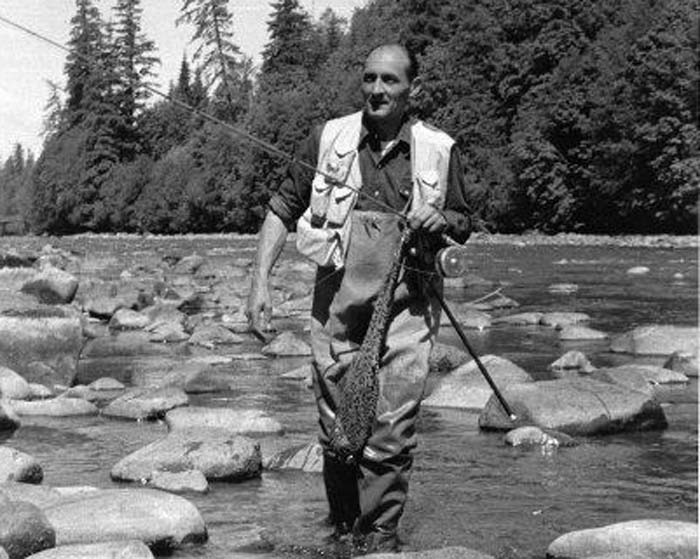
Born in Clarinda, Iowa, on December 23, 1902, Maclean was the son of Clara Evelyn (née Davidson; 1873–1952) and the Reverend John Norman Maclean (1862–1941), a Presbyterian minister, who managed much of the education of the young Norman and his brother Paul Davidson (1906–1938) until 1913. His parents had migrated from Nova Scotia, Canada. After Clarinda, the family relocated to Missoula, Montana in 1909. The following years considerably influenced and inspired his writings, appearing prominently in the short story The Woods, Books, and Truant Officers (1977), and semi-autobiographical novella A River Runs Through It and Other Stories (1976). Image provided courtesy of Alchetron.
In our family, there was no clear line between religion and fly fishing. . . .
An excerpt from A River Runs Through It
by Norman Maclean
[dropcap]I[/dropcap]n our family, there was no clear line between religion and fly fishing. We lived at the junction of great trout rivers in western Montana, and our father was a Presbyterian minister and a fly fisherman who tied his own flies and taught others. He told us about Christ’s disciples being fishermen, and we were left to assume, as my brother and I did, that all first-class fishermen on the Sea of Galilee were fly fishermen and that John, the favorite, was a dry-fly fisherman.
It is true that one day a week was given over wholly to religion. On Sunday mornings my brother, Paul, and I went to Sunday school and then to “morning services” to hear our father preach and in the evenings to Christian Endeavor and afterwards to “evening services” to hear our father preach again. In between on Sunday afternoons we had to study The Westminster Shorter Catechism for an hour and then recite before we could walk the hills with him while he unwound between services. But he never asked us more than the first question in the catechism, “What is the chief end of man?” And we answered together so one of us could carry on if the other forgot, “Man’s chief end is to glorify God, and to enjoy Him forever.” This always seemed to satisfy him, as indeed such a beautiful answer should have, and besides he was anxious to be on the hills where he could restore his soul and be filled again to overflowing for the evening sermon. His chief way of recharging himself was to recite to us from the sermon that was coming, enriched here and there with selections from the most successful passages of his morning sermon.
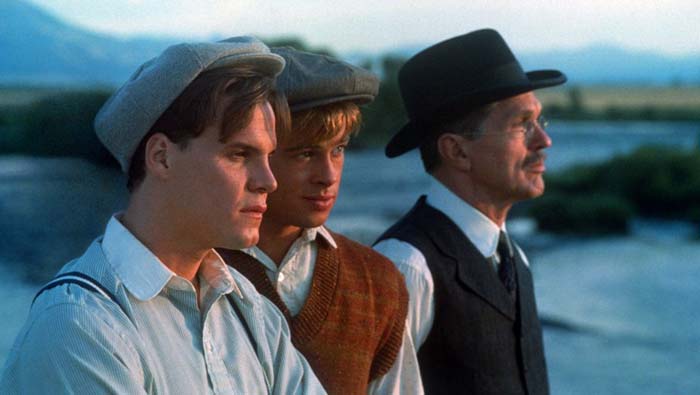
On Oct. 9, 1992, A River Runs Through It was released in theaters. Directed by Robert Redford, the drama about two preacher’s sons growing up in rural Montana starred a young Brad Pitt in his first lead role in a major studio film. See Hollywood Reporter‘s original review.
Even so, in a typical week of our childhood Paul and I probably received as many hours of instruction in fly fishing as we did in all other spiritual matters
After my brother and I became good fishermen, we realized that our father was not a great fly caster, but he was accurate and stylish and wore a glove on his casting hand. As he buttoned his glove in preparation to giving us a lesson, he would say, “It is an art that is performed on a four-count rhythm between ten and two o’clock.”
As a Scot and a Presbyterian, my father believed that man by nature was a mess and had fallen from an original state of grace. Somehow, I early developed the notion that he had done this by falling from a tree. As for my father, I never knew whether he believed God was a mathematician but he certainly believed God could count and that only by picking up God’s rhythms were we able to regain power and beauty. Unlike many Presbyterians, he often used the word “beautiful.”
After he buttoned his glove, he would hold his rod straight out in front of him, where it trembled with the beating of his heart. Although it was eight and a half feet long, it weighed only four and a half ounces. It was made of split bamboo cane from the far-off Bay of Tonkin. It was wrapped with red and blue silk thread, and the wrappings were carefully spaced to make the delicate rod powerful but not so stiff it could not tremble.

A YouTube screenshot of the A River Runs Through It movie track: “A Fine Fisherman and the Big Blackfoot River.”
Always it was to be called a rod. If someone called it a pole, my father looked at him as a sergeant in the United States Marines would look at a recruit who had just called a rifle a gun
My brother and I would have preferred to start learning how to fish by going out and catching a few, omitting entirely anything difficult or technical in the way of preparation that would take away from the fun. But it wasn’t by way of fun that we were introduced to our father’s art. If our father had had his say, nobody who did not know how to fish would be allowed to disgrace a fish by catching him. So you too will have to approach the art Marine and Presbyterian-style, and, if you have never picked up a fly rod before, you will soon find it factually and theologically true that man by nature is a damn mess. The four-and-a-half-ounce thing in silk wrappings that trembles with the underskin motions of the flesh becomes a stick without brains, refusing anything simple that is wanted of it. All that a rod has to do is lift the line, the leader, and the fly off the water, give them a good toss over the head, and then shoot them forward so they will land in the water without a splash in the following order: fly, transparent leader, and then the line—otherwise the fish will see the fly is a fake and be gone. Of course, there are special casts that anyone could predict would be difficult, and they require artistry—casts where the line can’t go over the fisherman’s head because cliffs or trees are immediately behind, sideways casts to get the fly under overhanging willows, and so on. But what’s remarkable about just a straight cast—just picking up a rod with a line on it and tossing the line across the river?
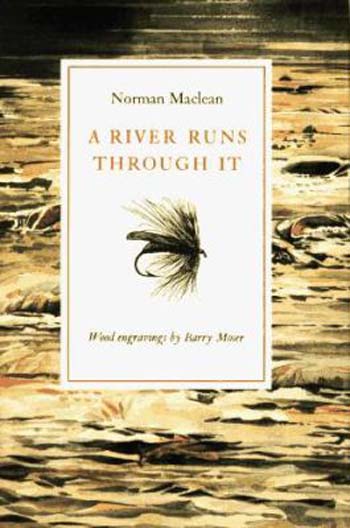
Click on cover to to find out about purchasing this classic.
Well, until man is redeemed he will always take a fly rod too far back, just as natural man always overswings with an ax or golf club and loses all his power somewhere in the air:
Only with a rod it’s worse, because the fly often comes so far back it gets caught behind in a bush or rock. When my father said it was an art that ended at two o’clock, he often added, “closer to ten than to two,” meaning that the rod should be taken back only slightly farther than overhead (straight overhead being twelve o’clock).
Then, since it is natural for man to try to attain power without recovering grace, he whips the line back and forth making it whistle each way, and sometimes even snapping off the fly from the leader, but the power that was going to transport the little fly across the river somehow gets diverted into building a bird’s nest of line, leader, and fly that falls out of the air into the water about ten feet in front of the fisherman. If, though, he pictures the round trip of the line, transparent leader, and fly from the time they leave the water until their return, they are easier to cast. They naturally come off the water heavy line first and in front, and light transparent leader and fly trailing behind. But, as they pass overhead, they have to have a little beat of time so the light, transparent leader and fly can catch up to the heavy line now starting forward and again fall behind it; otherwise, the line starting on its return trip will collide with the leader and fly still on their way up, and the mess will be the bird’s nest that splashes into the water ten feet in front of the fisherman.
Almost the moment, however, that the forward order of line, leader, and fly is reestablished, it has to be reversed, because the fly and transparent leader must be ahead of the heavy line when they settle on the water. If what the fish sees is highly visible line, what the fisherman will see are departing black darts, and he might as well start for the next hole. High overhead, then, on the forward cast (at about ten o’clock) the fisherman checks again.
The four-count rhythm, of course, is functional
The one count takes the line, leader, and fly off the water; the two count tosses them seemingly straight into the sky; the three count was my father’s way of saying that at the top the leader and fly have to be given a little beat of time to get behind the line as it is starting forward; the four count means put on the power and throw the line into the rod until you reach ten o’clock—then check-cast, let the fly and leader get ahead of the line, and coast to a soft and perfect landing. Power comes not from power everywhere, but from knowing where to put it on. “Remember,” as my father kept saying, “it is an art that is performed on a four-count rhythm between ten and two o’clock.”
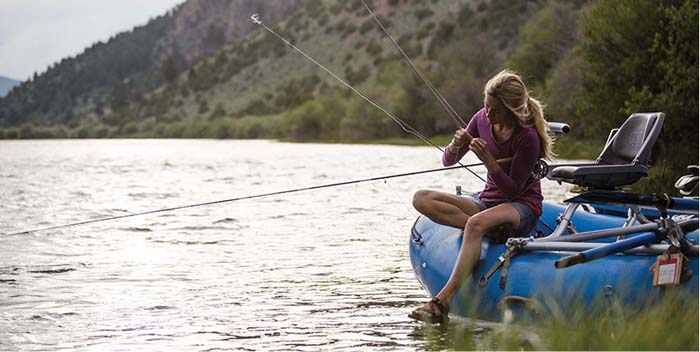
In the summer, things are more Montana style hurried than the Big Apple, Windy City, or City of Angels. Image by Orvis – Top Ten Trout Rivers to Fish in Montana.
My father was very sure about certain matters pertaining to the universe. To him, all good things—trout as well as eternal salvation—come by grace and grace comes by art and art does not come easy
So my brother and I learned to cast Presbyterian-style, on a metronome. It was mother’s metronome, which father had taken from the top of the piano in town. She would occasionally peer down to the dock from the front porch of the cabin, wondering nervously whether her metronome could float if it had to. When she became so overwrought that she thumped down the dock to reclaim it, my father would clap out the four-count rhythm with his cupped hands.
Eventually, he introduced us to literature on the subject. He tried always to say something stylish as he buttoned the glove on his casting hand. “Izaak Walton,” he told us when my brother was thirteen or fourteen, “is not a respectable writer. He was an Episcopalian and a bait fisherman.”” Although Paul was three years younger than I was, he was already far ahead of me in anything relating to fishing and it was he who first found a copy of The Compleat Angler and reported back to me, “The bastard doesn’t even know how to spell ‘complete.’ Besides, he has songs to sing to dairymaids.” I borrowed his copy, and reported back to him, “Some of those songs are pretty good.” He said, “Whoever saw a dairymaid on the Big Blackfoot River?
“I would like,” he said, “to get him for a day’s fishing on the Big Blackfoot—with a bet on the side.”
The boy was very angry, and there has never been a doubt in my mind that the boy would have taken the Episcopalian money
When you are in your teens—maybe throughout your life—being three years older than your brother often makes you feel he is a boy. However, I knew already that he was going to be a master with a rod. He had those extra things besides fine training—genius, luck, and plenty of self-confidence. Even at this age he liked to bet on himself against anybody who would fish with him, including me, his older brother. It was sometimes funny and sometimes not so funny, to see a boy always wanting to bet on himself and almost sure to win. Although I was three years older, I did not yet feel old enough to bet. Betting, I assumed, was for men who wore straw hats on the backs of their heads. So I was confused and embarrassed the first couple of times he asked me if I didn’t want “a small bet on the side just to make things interesting.” The third time he asked me must have made me angry because he never again spoke to me about money, not even about borrowing a few dollars when he was having real money problems.
We had to be very careful in dealing with each other. I often thought of him as a boy, but I never could treat him that way. He was never “my kid brother.”
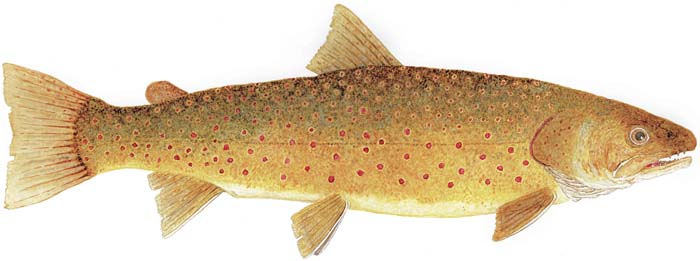
One of Montana’s most threatened trouts, the bull trout (Salvelinus confluentus). Illustration by award winning artist, Thom Glace.
He was a master of an art. He did not want any big brother advice or money or help, and, in the end, I could not help him
[information]
Copyright notice: Excerpted from pages 1-6 of A River Runs Through It, and Other Stories by Norman Maclean, published by the University of Chicago Press. ©1976 by the University of Chicago. All rights reserved. This text may be used and shared in accordance with the fair-use provisions of U.S. copyright law, and it may be archived and redistributed in electronic form, provided that this entire notice, including copyright information, is carried and provided that the University of Chicago Press is notified and no fee is charged for access. Archiving, redistribution, or republication of this text on other terms, in any medium, requires the consent of the University of Chicago Press.
Norman Maclean
A River Runs through It and Other Stories, Twenty-fifth Anniversary Edition
With a New Forward by Annie Proulx
Cloth $22.00 0-226-50072-1
Paper $12.00 0-226-50066-7
©1976, 2001 240 pages
For information on purchasing the book—from b
ookstores or here online—please go to the webpage for A River Runs Through It.
University of Chicago Press: 1427 E. 60th Street Chicago, IL 60637 USA | Voice: 773.702.7700 | Fax: 773.702.9756
[/information]


